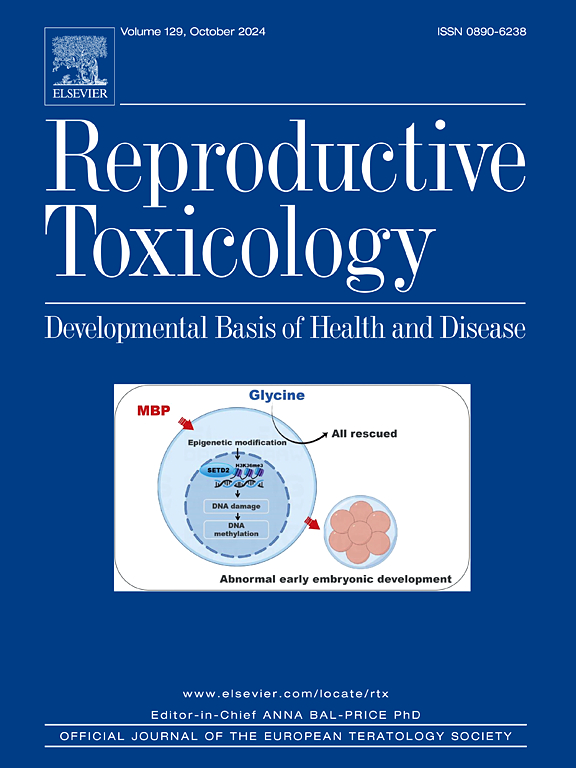对羟基苯甲酸丙酯对体外植入前小鼠胚胎发育的负面影响
IF 3.3
4区 医学
Q2 REPRODUCTIVE BIOLOGY
引用次数: 0
摘要
对羟基苯甲酸酯是一种广泛用于个人护理产品和食品中的抗微生物防腐剂。它们通过与雌激素受体1和2结合,表现出潜在的雌激素活性,将它们归类为内分泌干扰化学物质。鉴于女性每天大量接触对羟基苯甲酸酯,研究它们对女性生殖系统的影响至关重要。先前对小鼠模型的研究表明,对羟基苯甲酸酯暴露会影响卵巢发育,导致囊泡增加和黄体减少。然而,对羟基苯甲酸酯对胚胎发育的影响尚未得到广泛研究。本研究旨在确定对羟基苯甲酸丙酯暴露对体外着床前胚胎发育的影响。我们检测了0(0.075 % DMSO)、0.5 μg/mL、5.0 μg/mL、10 μg/mL和15 μg/mL对小鼠受精卵发育到囊胚孵化期的影响,定量了囊胚孵化期内细胞团(ICM)和滋养外胚层(TE)细胞的数量,以及细胞骨架f -肌动蛋白的分布。与对照组相比,0.5 μg/mL和10 μg/mL组囊胚孵化率显著降低。对羟基苯甲酸丙酯处理未改变TE细胞数量。然而,与对照组相比,0.5或15 μg/mL处理显著减少ICM细胞数量。此外,在10 μg/mL和15 μg/mL对羟基苯甲酸丙酯时,F-actin的phalloidin荧光染色强度显著降低。总之,我们的研究结果表明,对羟基苯甲酸丙酯暴露会破坏ICM的形成,影响细胞骨架丝状肌动蛋白(F-actin)网络,并改变着床前小鼠胚胎的孵化囊胚发育率。本文章由计算机程序翻译,如有差异,请以英文原文为准。
Propylparaben negatively impacts IN VITRO preimplantation mouse embryo development
Parabens are chemicals widely used in personal care products and food as antimicrobial preservatives. They exhibit potential estrogenic activity by binding to estrogen receptors 1 and 2, classifying them as endocrine-disrupting chemicals. Given the substantial daily exposure of women to parabens, it is crucial to investigate their effects on the female reproductive system. Previous studies in mouse models have shown that paraben exposure impacts ovarian development, resulting in an increase in cystic follicles and a decrease in corpora lutea. However, the effects of parabens on embryo development have not been extensively studied. This study aimed to determine the impact of propylparaben exposure on preimplantation embryo development in vitro. We tested the effects of 0 (0.075 % DMSO), 0.5 μg/mL, 5.0 μg/mL, 10 μg/mL, and 15 μg/mL propylparaben on rate of development of mouse zygotes to hatched blastocyst stage, quantified the number of inner cell mass (ICM) and trophectoderm (TE) cells in hatched blastocysts, and the distribution of cytoskeletal F-actin. The percentage of hatched blastocysts was significantly decreased at 0.5 μg/mL and 10 μg/mL compared to controls. Propylparaben treatment did not alter TE cell numbers. However, treatment with 0.5 or 15 μg/mL significantly decreased the number of ICM cells compared to controls. Additionally, the intensity of phalloidin fluorescence staining for F-actin was significantly reduced at 10 μg/mL and 15 μg/mL propylparaben. In summary, our findings show that propylparaben exposure disrupts ICM formation, impacts the cytoskeletal filamentous actin (F-actin) network, and alters the rate of hatched blastocyst development in preimplantation mouse embryos.
求助全文
通过发布文献求助,成功后即可免费获取论文全文。
去求助
来源期刊

Reproductive toxicology
生物-毒理学
CiteScore
6.50
自引率
3.00%
发文量
131
审稿时长
45 days
期刊介绍:
Drawing from a large number of disciplines, Reproductive Toxicology publishes timely, original research on the influence of chemical and physical agents on reproduction. Written by and for obstetricians, pediatricians, embryologists, teratologists, geneticists, toxicologists, andrologists, and others interested in detecting potential reproductive hazards, the journal is a forum for communication among researchers and practitioners. Articles focus on the application of in vitro, animal and clinical research to the practice of clinical medicine.
All aspects of reproduction are within the scope of Reproductive Toxicology, including the formation and maturation of male and female gametes, sexual function, the events surrounding the fusion of gametes and the development of the fertilized ovum, nourishment and transport of the conceptus within the genital tract, implantation, embryogenesis, intrauterine growth, placentation and placental function, parturition, lactation and neonatal survival. Adverse reproductive effects in males will be considered as significant as adverse effects occurring in females. To provide a balanced presentation of approaches, equal emphasis will be given to clinical and animal or in vitro work. Typical end points that will be studied by contributors include infertility, sexual dysfunction, spontaneous abortion, malformations, abnormal histogenesis, stillbirth, intrauterine growth retardation, prematurity, behavioral abnormalities, and perinatal mortality.
 求助内容:
求助内容: 应助结果提醒方式:
应助结果提醒方式:


